Handicrafts are a fascinating process, created with your own hands, mood, thoughts, and energy. The work turns out to be interesting and entertaining! Unusual knitting patterns are made by the skill of a needlewoman. Due to the great demand, patterns with descriptions and diagrams are becoming the main ones. Considering the cold time, it is nice to warm up with a knitted thing, and at that, a beautiful one.
Classic knitting patterns with knitting needles
Classic knitting consists of 2 basic loops, front and back. With the classic method, the loop is knitted behind the front wall. The classic knitting method is convenient and comfortable. The new ornament is accompanied by a description, diagrams, illustrations.
Garter stitch from thick yarn with detailed description
Garter stitch is a knitting element on both sides. The ornament is suitable for winter season products. Garter stitch remarkably maintains an unchanged shape, protects the original appearance of the fabric from being damaged. This knitting does not curl the edges. The clothes look airy.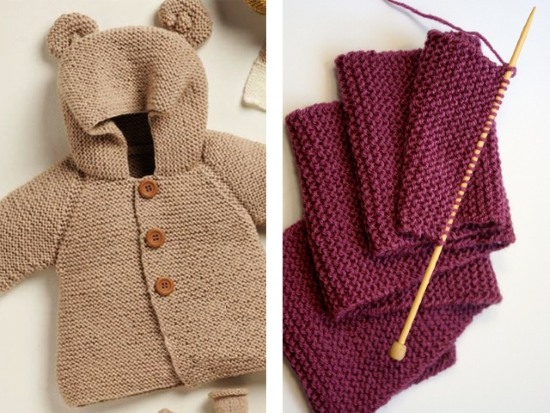
Garter stitch is divided into several variants, which are described below.
Classic garter stitch
Classic garter stitch is an easy option. It is made with standard loops.
Scheme:
- Cast on 20 stitches and knit as shown in the picture;
- Remove the 1st edge loop to make the edge neat;
- Knit, pull the needle through the loop in front and pull the thread out from behind. Knit like this until the end of the row;
- Knit the final loop purlwise. The needle passes behind the loop, catches the thread in front;
- Turn the fabric over and knit in a similar way to the 1st row, knit stitches, except for the edge stitches located along the edges.
Garter stitch with granny stitches
This option is the most difficult method of needlework.
Scheme:
- Knit the required number of loops in the 1st row;

- 1st loop remove and do not knit, then knit;
- 1st row of knit stitches;
- Turn the fabric over - purl loops;
- 1st loop remove;
- Working thread - knit purlwise, as if to knit;
- To knit garter stitch, knit the odd rows around, and purl the even rows.
Garter stitch with purl stitches
Needlewomen also use this knitting method, which is knitted from the back loop. Due to the fact that the result of the pattern is uneven, an openwork effect is given.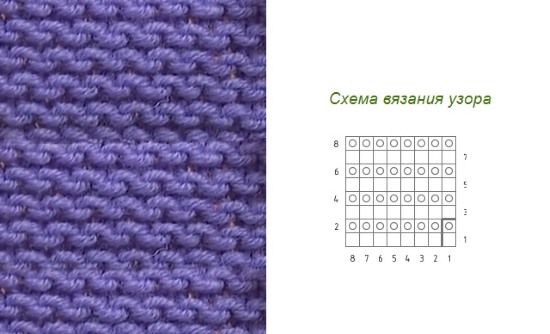
Scheme:
- Cast on a sufficient number of loops, do not forget about the 1st removed loop at the end, edge;
- Take the knitting needle behind the thread. The working thread is located to the right of the loop, that is, on the left knitting needle;
- 1 – the knitting needle is inserted into the left loop, under the thread;
- To form a purl loop, use the end of the knitting needle in your right hand to grab the thread;
- The rest of the running stitches are purl stitches, not counting the edge stitch.
Openwork patterns for women's products
The beauty and elegance of openwork patterns for knitting with knitting needles with descriptions and diagrams delight with a variety of ideas. Openwork patterns decorate a summer sundress, top, dresses. They are suitable as a separate element for the beauty of the product. Openwork patterns are used in decorative knitting, for example, tablecloths, napkins, bedspreads. In women's products, the rows are directed to the left.
The cape is the main element without which openwork cannot be done.
An excellent result in openwork knitting depends on the correct selection of needles and yarn. You can choose any type of yarn: viscose, cotton, silk, thin wool, fleecy threads. For an airy and light product, choose thick needles and thin yarn, for example, mohair or angora. For a dense product, choose thin needles and thick yarn.
The thread thickness for the summer version of the products should be thin, and for the sporty look - thick. Openwork patterns are a combination of small holes, an intricate or simple pattern.
Sea foam from knit and purl loops with knitting needles
The pattern "Sea foam" is perfect for knitting sweaters, jackets, dresses. The pattern is combined on a children's product, women's, men's. It can be a summer jacket, a warm sweater, depending on the structure of the thread.
Let's take a closer look at the ornament with a description and diagram:
- The 1st and 2nd rows should be knitted with front loops;
- 3rd row: 6 knits, yarn over, 1 knit, double yarn over, 1 knit, triple yarn over, 1 knit, double yarn over, 1 knit, yarn over, 6 knit stitches;
- 4th row: you need to knit it with front loops, drop the yarn over during the connection (transfer to another knitting needle);
- 5th and 6th rows knit with front loops;
- On the 7th follow a different plan: 1 front loop, yarn over, 1 front loop, double yarn over, 1 front loop, triple yarn over, 1 front loop, double yarn over, 1 front loop, yarn over, 6 front loops, yarn over, 1 front loop, double yarn over, 1 front loop, triple yarn over, 1 front loop, double yarn over, 1 front loop, yarn over, 1 front loop;
- The 8th row is knitted like the 4th.
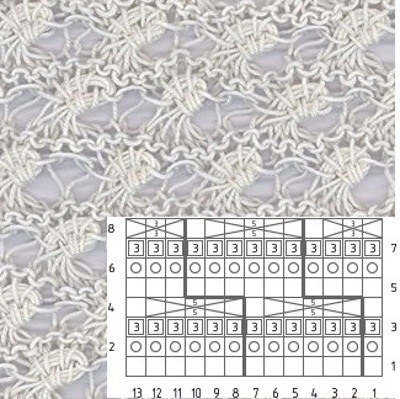
To get the pattern you need to knit, repeating rows 1–8 all the time.
Leaves - leaves made from knit and purl stitches
The “Leaves – Leaves” pattern is ideal for children’s products.
Scheme:
- 1st row: 2 purl, 1 knit, yarn over, 1 knit, yarn over, 3 knit loops, together. You need to pick up the loops by the back walls (turn the loops in advance), 8 knit, 2 purl;
- 2nd row, even (purl) rows: 2 front loops, 13 back loops (including capes), 2 front loops;
- 3rd row: 2 purl, 2 knit, yarn over, 1 knit, yarn over, 1 knit, 3 knit stitches, together behind back, walls, 6 knit, 2 purl;
- 5th row: 2 purl, 3 knits, yarn over, 1 knit, yarn over, 2 knits, 3 knit stitches, together behind back, walls, 4 knits, 2 purl;
- 7th row: 2 purl, 4 knits, yarn over, 1 knit, yarn over, 3 knits, 3 knit stitches, together behind back, walls, 2 knits, 2 purl;
- 9th row: 2 purl, 8 knit, 3 knit stitches, together behind the front, walls, yarn over, 1 knit, yarn over, 1 knit, 2 purl;
- 11th row: 2 purl, 6 knits, 3 knit stitches, together behind the front, walls, yarn over, 1 knit, yarn over, 2 knits, 2 purl;
- 13th row: 2 purl, 4 knits, 3 knit stitches, together behind the front, walls, 2 knits, yarn over, 1 knit, yarn over, 3 knits, 2 purl;
- 15th row: 2 purl, 2 knit, 3 knit stitches, together behind the front, walls, 3 knit, yarn over, 1 knit, yarn over, 4 knit, 2 purl.
Bells with holes
The pattern "Bells with holes" comes out originally when knitting with thin threads and thick threads. Suitable for both children's and women's clothing.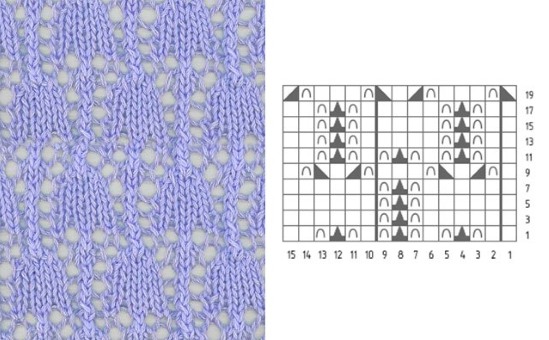
Scheme:
- 1st and 11th rows: 1 front loop, 1 front loop, yarn over, 3 front loops, together (with center loop), yarn over, 1 front, yarn over, 3 front loops, together (with center loop), yarn over, 1 front, yarn over, 3 front loops, together (with center loop), yarn over, 2 front;
- 2nd row, all even rows: all loops purl;
- 3, 5, 7 rows: 1 front, 5 front, yarn over, 3 front loops, together (with center loop), yarn over, 6 front;
- 9th row: 1 front, yarn over, 2 front loops, together behind the front, walls, 1 front, 2 front loops, together behind the back, walls (roll the loops in advance), yarn over, 3 front, yarn over, 2 front loops, together behind the front, walls, 1 front, 2 front loops, together behind the back, walls (roll the loops in advance), yarn over, 1 front;
- 13,15,17 rows: 1 front, 1 front, yarn over, 3 front loops, together (with center loop), yarn over, 4 front, 1 front, yarn over, 3 front loops, together (with center loop), yarn over, 2 front;
- Row 19: 2 front loops, together, behind back, walls (fold the loops in advance), yarn over, 3 front loops, yarn over, 2 front loops, together behind front, walls, 1 front loop, 2 front loops, together behind back, walls (fold the loops in advance), yarn over, 3 front loops, yarn over, 2 front loops, together behind front, walls.
Again, continue the pattern from the 1st row.
Checkerboard
The "Checkerboard" pattern has different knitting methods. Simple, beginners can knit. The pattern has two sides of the bundle, the product becomes denser. The ornament is uniform on both sides. The knitting pattern is suitable for warm clothes, bags, sweaters.
Classic chess
This pattern is often found for knitting and is considered the most famous. The difference between the "Checkerboard" 4 × 4 and the standard ornament is the shift in the checkerboard order of the persons., and izn. loops.
Drawing:1 shift of the pattern in 21 rows, another shift through 10 rows, 3 shift through 8 rows, subsequent shifts through 6 rows, knit to a certain length.
This pattern is for a hat. It is knitted in a circle, after finishing knitting the hat is sewn.
Classic genre – “Checkerboard” pattern 4 × 4. The number of loops is a multiple of 4 + 2 loops for the edge.
Scheme:
- 1 row: 4 front, 4 back;
- The 2nd row and the remaining even rows are knitted according to the pattern of the fabric;
- 3rd row: 4 knits, 4 purl;
- 5th row: 4 purl, 4 knit;
- 7th row: 4 purl, 4 knit;
- Row 9: the same from row 1.
In the same position, knit “Checkerboard” 2 × 2, 3 × 3, 5 × 5, 6 × 6, 8 × 8, changing the number of rows.
Alternative Chess
The “Alternative Checkerboard” pattern is a different knitting option based on the checkerboard pattern.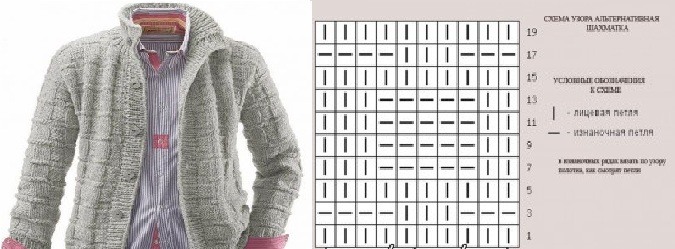
Drawing:The pattern repeat is 10 loops. The pattern shows odd rows, and even rows are knitted as the loops are located. The ornament continues from row 1 to 20.
Checkerboard braid
The "Checkerboard Braid" ornament depicts a wicker basket. Due to the fact that the front and back loops alternate, a relief pattern is formed. It looks effective on sweaters knitted on knitting needles. The pattern is formed from 10 elements.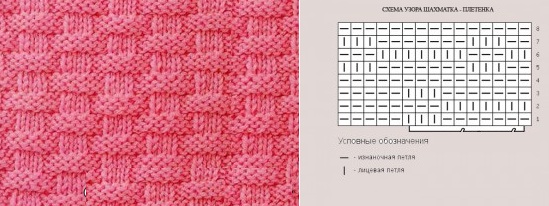
Drawing: shown are knit, purl, rows. Repeat rows 1–8.
Striped checkerboard
The "Striped Checkerboard" pattern resembles the "Braid Checkerboard". It is knitted in garter stitch, all loops are knit, with inclusions of 3 × 3 knits, stocking stitch, in knits, – knit stitches, in purl, – purl stitches.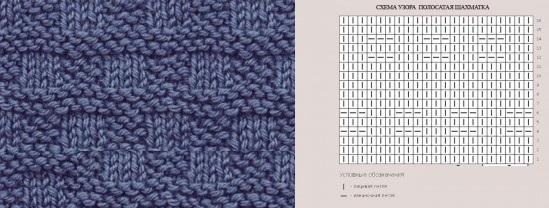
Drawing: The pattern repeat is 6 loops + 3 loops. The pattern shows front, back and rows.
Scheme:
- The 1st and odd rows are knitted in knit stitches;
- 2nd row of front loops;
- 4th and 6th rows: 3 purl, 3 knit, 3 purl;
- 8th and 10th rows: knit;
- 12th and 14th rows: 3 knits, 3 purl, 3 knits;
- 16th row: all front loops.
Continue the pattern upwards, rows 1–16.
Chessboard confusion
The ornament "Checkerboard confusion" consists of squares of faces, surfaces. The ornament looks like faces, rows, backs.  The pattern is constructed from 14 loops, 20 rows.
The pattern is constructed from 14 loops, 20 rows.
Braided lace
The depicted pattern "Openwork braid" is made from 8 loops, 12 rows. The drawing is depicted front, back, in rows. 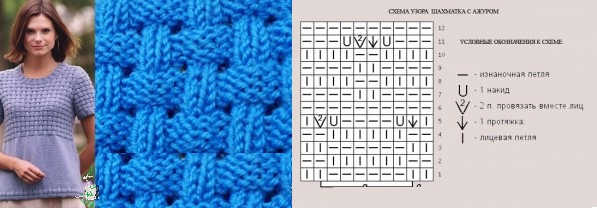 Where 2 elements are knitted together, create a tilt to the right. The point is first inserted into the 2nd loop, the 1st, knitted together.
Where 2 elements are knitted together, create a tilt to the right. The point is first inserted into the 2nd loop, the 1st, knitted together.
Bow
Knitting pattern, combines a pattern similar to a bow. It is performed with purl, satin stitch on the background of the face. It consists of 10 rows, in height and 9 loops. 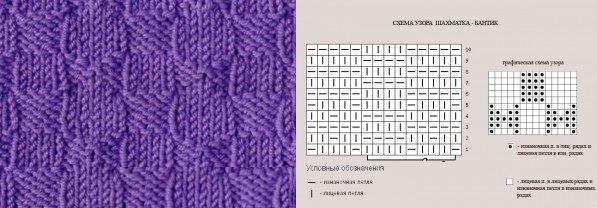 Standard diagram with description is added with graphic drawing. Purl, knit, row are shown in the photo.
Standard diagram with description is added with graphic drawing. Purl, knit, row are shown in the photo.
Caramel mesh
Mesh patterns for knitting look like an openwork insert or as a main pattern. Such effective elements when knitting on needles, and various forms surprise with beauty and originality. Mesh patterns are in demand in the spring. They look good on summer sweaters, tops, scarves and voluminous jumpers. There are many options for use. Description and diagrams - below.
The "Mesh" pattern for knitting can be:
- large knot;
- small knot;
- on both sides;
- single;
- perpendicular;
- diagonally;
- intricate;
- elementary.
By adding capes and knitting 2, 3 loops together, we get mesh patterns.
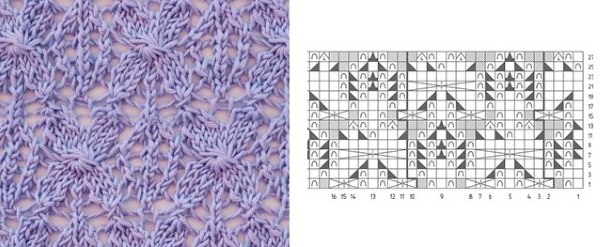 Detailed diagram with description:
Detailed diagram with description:
- 1 row: 1 knit, yarn over, 3 together, yarn over, 1 knit, yarn over, 3 together, yarn over, 1 knit, yarn over, 3 together, yarn over, 1 knit, yarn over, 3 together from 3, yarn over, 1 knit;
- 3rd row: 2 persons., yarn over, 1 persons., 1 persons., 2 persons together, behind back, walls, yarn over, 1 persons., yarn over, 2 loops together persons., behind front, walls, 2 persons., yarn over, 3 persons., yarn over, 1 persons., 1 persons., 2 persons., together behind back, walls, yarn over, 1 persons., yarn over, 2 persons., together behind front, walls, 2 persons., yarn over, 2 persons.;
- 5th row: 1 front loop, yarn over, 2 front loops, together behind back, walls, yarn over, 2 front loops, 2 front loops, 2 front loops, 1 front loop, 2 front loops, yarn over, 2 front loops, 1 front loop, yarn over, 2 front loops, 1 front loop, yarn over, 2 front loops, 2 front loops, 2 front loops, 1 front loop, 2 front loops, yarn over, 2 front loops, 1 front loop;
- 7th row: 2 loops, together behind back, walls, yarn over, 2 loops, together behind back, walls, yarn over, 7 loops, from 7 behind back, walls, yarn over, 2 persons, together behind front, walls, yarn over, 3 persons, together with center, loop, yarn over, 2 persons, together behind back, walls, yarn over, 7 from 7 behind back, walls, yarn over, 2 persons, together behind front, walls, yarn over, 2 together behind front, walls;
- 9th row: 2 persons., together behind back., walls, yarn over, 2 together behind back., walls, yarn over, 7 persons., yarn over, 2 persons., together behind front., walls, yarn over, 3 together with center., loop, yarn over, 2 together behind back., walls, yarn over, 7 persons., yarn over, 2 together behind front., walls, yarn over, 2 together behind front., walls;
- 11th row: 1 front, 2 front, together behind the front, walls, yarn over, 2 together behind the front, walls, 2 front, yarn over, 2 front, together behind the back, walls, 1 front, 2 together behind the back, walls, yarn over, 2 together behind the back, walls, 1 front, 2 together behind the front, walls, yarn over, 2 together behind the front, walls, 2 front, yarn over, 2 together behind the back, walls, 1 front, 2 together behind the back, walls, yarn over, 2 together behind the back, walls, 1 front;
- Row 13: 2 knits, fused behind back, walls, yarn over, 4 fused behind back, walls, yarn over, 3 fused with center, yarn over, 4 fused behind back, walls, yarn over, 1 knit, yarn over, 4 fused behind back, walls, yarn over, 2 fused behind back, walls;
- Row 15: 1 knit, cape, knit 3 of 3, cape, 1 knit, cape, 3 of 3 loops, cape, 1 knit, cape, 3 of 3, cape, 1 knit, cape, 3 of 3, cape, 1 knit, cape, 3 of 3, cape, 1 knit;
- Row 17: 1 front, yarn over, 2 front, together behind the front, walls, 1 front, 1 front, yarn over, 3 front, yarn over, 2 front, 2 together behind the back, walls, yarn over, 1 front, 2 together behind the front, walls, 1 front, 1 front, yarn over, 3 front, yarn over, 2 front, 2 together behind the back, walls, yarn over, 1 front;
- Row 19: 1 front, 2 together behind the front, walls, 2 front, yarn over, 2 together behind the front, walls, yarn over, 1 front, yarn over, 2 together behind the back, walls, yarn over, 2 front, 2 together behind the back, walls, 1 front, 2 together behind the front, walls, 2 front, yarn over, 2 together behind the front, walls, yarn over, 1 front, yarn over, 2 together behind the back, walls, yarn over, 2 front, 2 together behind the back, walls, yarn over, 1 front;
- 21 row: 4 persons., yarn overs, 2 together behind the front., walls, yarn overs, 3 together with the center., loop, yarn overs, 2 together behind the back., walls, yarn overs, knit 7 of 7, yarn overs, 2 together behind the front., walls, yarn overs, 3 together with the center., yarn overs, 2 together behind the back., walls, yarn overs, 4 persons.;
- Row 23: 4 persons, yarn overs, 2 together behind the front, walls, yarn overs, 3 together with the center, loop, yarn overs, 2 together behind the back, walls, yarn overs, 7 persons, yarn overs, 2 together behind the front, walls, yarn overs, 3 together with the center, yarn overs, 2 together behind the back, walls, yarn overs, 4 persons;
- Row 25: yarn over, 2 together behind back, walls, 1 front, 2 together behind back, walls, yarn over, 2 together behind back, walls, 1 front, 2 together behind front, walls, yarn over, 2 together behind front, walls, 2 front, yarn over, 2 together behind back, 1 front, 2 together behind back, yarn over, 2 together behind front, 1 front, 2 together behind front, yarn over;
- Row 27: 1 front, yarn over, 4 front, behind back, yarn over, 3 together with center, yarn over, 4 together with center, yarn over, 3 together with center, yarn over, 4 together with back, yarn over, 1 front, yarn over, 4 together with back, yarn over, 3 together with center, yarn over, 4 together with back, yarn over, 1 front;
- Row 29: repeat the pattern from the beginning.
Bulgarian cross pattern
The "Bulgarian cross" ornament is suitable for the summer version of the products. This knitting pattern with a description and diagrams is obtained by throwing loops and capes. In the front row, you need to knit 3 front loops, and then throw the initial one over the 2nd, 3rd loop, then cape, knit until the end of the row. In the out., rows, all loops need to be knitted out. In the new front row, the pattern is shifted by 1 loop.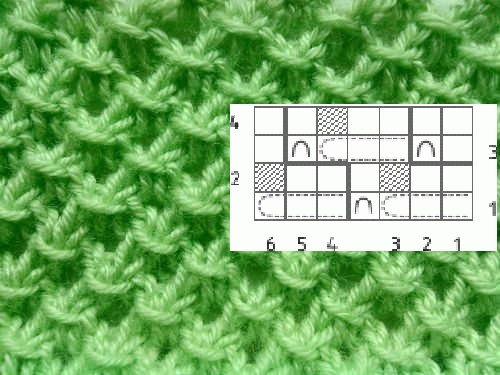
Scheme:
- 1st row: 3 persons, the initial loop must be thrown to the left side, on the 2nd, 3rd loop, yarn over, 3 persons, the initial loop must be thrown to the left side;
- 2nd and other even rows: purl;
- 3rd row: 1 knit, 3 knits, throw 1 to the left side, onto the 2nd and 3rd loops, yarn over, 1 knit. The pattern must be repeated from the 1st to the 4th rows.
Openwork snake
The openwork pattern "Snake" for knitting is one-sided, is considered not difficult and is suitable for beginners. It looks great in the summer version of women's and children's clothing.
Let's take a closer look at the "Snake" pattern with a description and diagram:
- 1st row: 2 purl, 2 knit, 2 purl stitches;
- 2nd row, even: you need to knit as the pattern turns out;
- 3rd row: 2 purl, yarn over, 2 knit, joined to the left side, 2 purl loops;
- 5th row: 2 purl, 2 knit, together to the right side, yarn over, 2 purl. loops.
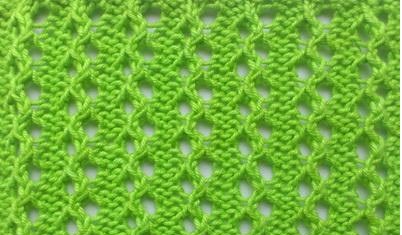
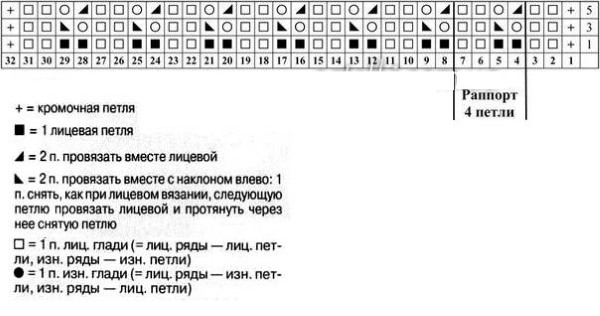
Knitting patterns with descriptions and diagrams can be used for knitting hats, scarves, sweaters and other clothing items.
Fashionable knitted women's clothing can never do without openwork items. For manufacturing, you need endurance, desire, the ability to knit on knitting needles and the choice of original knitting patterns. With ordinary manipulations, you can learn the lessons of weaving such a beautiful art and please your loved ones with new wardrobe items made with your own hands, and therefore, with soul and love.
Video: knitting patterns with descriptions and diagrams
How to knit an openwork pattern with knitting needles, watch the video:
Knitting pattern "Rhombuses", master class:

Many women, grandmothers and even girls are fond of knitting, although there are many ready-made knitted models in clothing stores. But handwork is always valued higher, and therefore descriptions and patterns of knitting with knitting needles are important for women who do needlework as a hobby or a means of earning money. Thanks for the article!
Thank you very much, I liked it, it’s a very simple drawing but it looks great.